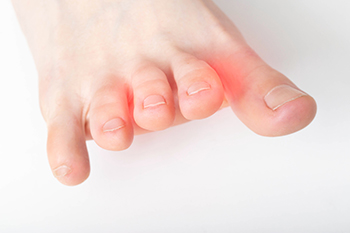
The plantar fascia is located on the sole of the foot and it connects the toes to the heels. Some patients may experience a growth that develops inside the plantar fascia, which is often benign. This is referred to as a plantar fibroma that might cause pain while walking and running. It is noticeable by the lump that forms on the bottom of the foot, generally in the center of the arch. The majority of experts agree it occurs due to genetic reasons or medical conditions like epilepsy, diabetes, and alcoholism. Other people can argue a plantar fibroma may develop after an injury occurs to the plantar fascia and the lump may be a natural reaction to the stress from the trauma. Mild relief may be found when the shoes that are worn have extra cushioning, or it may be beneficial to wear custom-made orthotics. If you have developed this condition it is advised that you are under the care of a podiatrist who can provide the treatment options that are correct for you.
A plantar fibroma may disrupt your daily activities. If you have any concerns, contact one of our podiatrists of Jill Einhorn, DPM and James Einhorn, DPM. Our doctors can provide the care you need to keep you pain-free and on your feet.
Plantar Fibroma
A plantar fibroma is a fibrous knot in the arch of the foot. It is embedded in the plantar fascia which is a band of tissue that extends from the heel to the toes along the bottom of the foot. There can be multiple plantar fibromas in the feet at the same time. There are no known causes for this condition. If you have a plantar fibroma, there will be a bump in the arch of your foot that cannot be missed. Any associated pain is most often due to a shoe rubbing against the nodule. Non-surgical options, such as steroid injections, physical therapy, and orthotics should be tried first. Surgery is a last resort and is the only thing that will remove a plantar fibroma entirely. Consult with a podiatrist for a proper diagnosis and to determine the treatment regimen that is right for you.
What Causes a Plantar Fibroma?
While there are no specific causes identified, a plantar fibroma can possibly come from genetic predisposition or the formation of scar tissue that forms from healing the tears in the plantar fascia.
What Are the Symptoms of a Plantar Fibroma?
There will be a noticeable lump in the arch of the foot that may or may not cause pain. If pain is felt, it is typically because a shoe is rubbing up against the lump or when walking or standing barefoot.
Treatment and Prevention
A plantar fibroma will not disappear without treatment, but it can get smaller and be a non-issue. If pain persists, a podiatrist examines the foot and when the arch of the foot is pressed, pain can be felt down to the toes. An MRI or biopsy might be performed to help diagnose or evaluate the plantar fibroma. The following non-surgical options are generally enough to reduce the size and pain of these nodules:
Surgery is considered if the mass increases in size and the patient continues to feel pain after non-surgical methods are tried.
If you have any questions please feel free to contact our offices located in Brooklyn and Astoria, NY . We offer the newest diagnostic tools and technology to treat your foot and ankle needs.

Many people experience foot pain, and there are several areas of the foot where this can occur. These can include the heel, arch, toes, or soles of the feet, and there are various reasons for pain to develop in different parts of the foot. Pain in the big toe may indicate the painful condition that is known as gout, or it may be arthritis, both of which affect the joints. A bunion is a bump that develops on the side of the big toe and may cause pain as shoes are worn. A corn on the pinky toe is one of the most painful foot conditions there is, despite its small size. It often develops as a result of wearing shoes that do not fit correctly. There are several causes for foot pain to occur, and these can consist of standing on hard surfaces for most of the day, being overweight, or having endured a foot injury. If you have foot pain for any reason, please consult with a podiatrist, sooner rather than later, who can accurately determine the reason why and offer effective treatment solutions.
Foot Pain
Foot pain can be extremely painful and debilitating. If you have a foot pain, consult with one of our podiatrists from Jill Einhorn, DPM and James Einhorn, DPM. Our doctors will assess your condition and provide you with quality foot and ankle treatment.
Causes
Foot pain is a very broad condition that could be caused by one or more ailments. The most common include:
Diagnosis
To figure out the cause of foot pain, podiatrists utilize several different methods. This can range from simple visual inspections and sensation tests to X-rays and MRI scans. Prior medical history, family medical history, and any recent physical traumatic events will all be taken into consideration for a proper diagnosis.
Treatment
Treatment depends upon the cause of the foot pain. Whether it is resting, staying off the foot, or having surgery; podiatrists have a number of treatment options available for foot pain.
If you have any questions, please feel free to contact our offices located in Brooklyn and Astoria, NY . We offer the newest diagnostic and treatment technologies for all your foot care needs.

Runners who do not care for their feet or practice good foot care habits can be setting themselves up for a nasty foot injury. If you are a runner, ensure that you are doing everything you can to protect your foot from injury. One important precautionary step you can take is to run easy, or non-strenuously, during scheduled easy running days. For example, when a runner exerts themselves on such days, it can tire the feet and make running at a high pace more difficult during harder runs. Taking easy days too seriously can also add extra stress to the feet, making them more susceptible to injury. If you are a runner, ensure that you are doing what you can to protect them from injuries. Working with a podiatrist can greatly help in this respect. Schedule an appointment today.
Exercising your feet regularly with the proper foot wear is a great way to prevent injuries. If you have any concerns about your feet, contact one of our podiatrists of Jill Einhorn, DPM and James Einhorn, DPM. Our doctors will treat your foot and ankle needs.
How to Prevent Running Injuries
Many common running injuries are caused by overuse and overtraining. When the back of the kneecap starts wearing out and starts causing pain in your knee, this is commonly referred to as runner’s knee. Runner’s knee is a decrease in strength in your quadriceps and can occur if you’re not wearing properly fitted or supporting shoes. To prevent runner’s knee, focusing on hip strengthening is a good idea, as well as strengthening your quads to keep the kneecaps aligned.
What Are Some Causes of Running Injuries?
- One cause of a common running injury is called iliotibial band syndrome.
- Plantar fasciitis is also another common injury.
- Stress fractures can occur from overtraining, lack of calcium, or even your running style.
Best Ways to Prevent Running Injuries
- Wear footwear that fits properly and suits your running needs.
- Running shoes are the only protective gear that runners have to safeguard them from injury.
- Make a training schedule. Adding strengthening exercises as well as regular stretching can help keep you strong and limber and can lessen the possibility of injuries.
- Stretching keeps muscles limber; this will help you gain better flexibility.
If you have any questions please feel free to contact our offices located in Brooklyn and Astoria, NY . We offer the newest diagnostic and treatment technologies for all your foot and ankle needs.

The foot condition that is known as Morton’s neuroma can cause debilitating pain and discomfort. This is an ailment that affects the nerve which lies between the third and fourth toes, causing it to become thickened and irritated. It is a condition that can be common among women who frequently wear high heels. These types of shoes generally have little area in the toe box, prohibiting the toes to move freely. Patients who have Morton’s neuroma often liken the pain in their feet to having a pebble or marble in their shoe. Additionally, there may be a burning sensation in the ball of the foot, as a result of extreme inflammation. There may be existing conditions affecting the feet which can lead to getting this condition, including bunions, flat feet, or high arches. A proper diagnosis consists of pressing on specific areas of the affected foot, and an X-ray may be taken to rule out fractures or arthritis. The discomfort from this ailment is difficult to ignore, and if you are afflicted with this type of pain, please schedule an appointment with a podiatrist as quickly as possible who can help you to find relief.
Morton’s neuroma is a very uncomfortable condition to live with. If you think you have Morton’s neuroma, contact one of our podiatrists of Jill Einhorn, DPM and James Einhorn, DPM. Our doctors will attend to all of your foot care needs and answer any of your related questions.
Morton’s Neuroma
Morton's neuroma is a painful foot condition that commonly affects the areas between the second and third or third and fourth toe, although other areas of the foot are also susceptible. Morton’s neuroma is caused by an inflamed nerve in the foot that is being squeezed and aggravated by surrounding bones.
What Increases the Chances of Having Morton’s Neuroma?
Morton’s neuroma is a very treatable condition. Orthotics and shoe inserts can often be used to alleviate the pain on the forefront of the feet. In more severe cases, corticosteroids can also be prescribed. In order to figure out the best treatment for your neuroma, it’s recommended to seek the care of a podiatrist who can diagnose your condition and provide different treatment options.
If you have any questions, please feel free to contact our offices located in Brooklyn and Astoria, NY . We offer the newest diagnostic and treatment technologies for all your foot care needs.